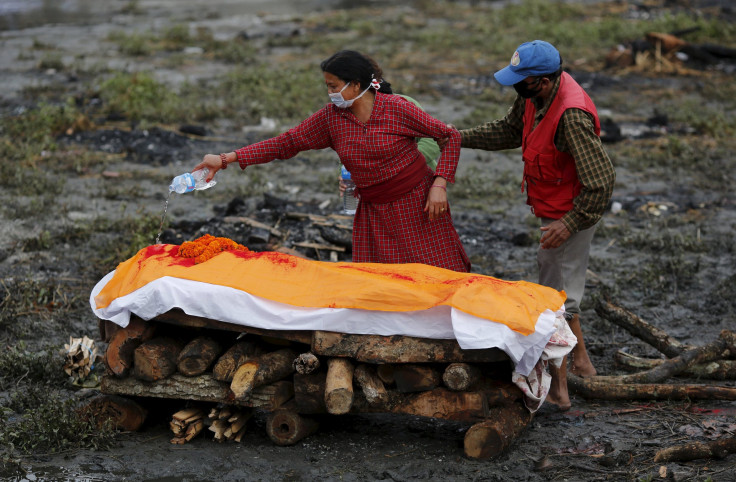Nepal Earthquake Relief: Rural Villages Starved Of Aid, Shelter, Medicine, As Aid Workers Warn Death Toll Could Rise Further

Outside the muddy rubble of collapsed homes, residents of many villages in rural areas of Nepal have been weathering rain, hunger and fears of aftershocks, spending cold nights out in the open air. They have waited days for food, critical medical treatment and shelter to arrive after a devastating earthquake struck the country Saturday. On the third day after the quake, many are still waiting.
As workers contend with unforgiving terrain, broken roads, rains and landslides in their efforts to reach rural and isolated parts of the country, relief organizations described the humanitarian situation in these villages in the direst of terms. They warned that the death toll could be several times higher than the 5,000 that has been reported, with some villages completely destroyed, when contact with villages is eventually established.
“Children and babies are sleeping in the rain, scores of people have died, and no help has arrived,” Dr. Kate Schecter, the president of World Neighbors, an international aid organization, said, describing Bahunepati, a mountainous and remote area that she said a former employee of the organization had visited after the quake. “One hundred percent of the homes have been destroyed,” she added.
Villagers whose houses were destroyed have little choice but to sleep outdoors, even if they are poorly equipped to do so. “The nights here in the mountains are quite cold and people are not set up to sleep outside, especially with very young children, including infants,” Mike Thiedke, with the children's charity Plan UK, wrote Monday from Hatauda, three hours from the capital, Kathmandu. The organization was working on distributing blankets so that people did not freeze.
In other rural areas, residents and relief workers reported shortages of food, water and medical care. “We haven’t had any food here since the earthquake,” one resident in Lapu, Gorkha, an area near the earthquake’s epicenter and one of the districts hit worst, told Agence France-Press.
In the district of Gorkha, one of Nepal's worst hit, helicopters ferried residents from more remote villages into the central town. One woman, from Ranachour village, arrived in the central town with of her both legs badly broken. They were tied together in a makeshift splint made of hay, the Associated Press reported.
Inclement weather in an unforgiving terrain, plus damaged roads and weak communication, has also hampered efforts to provide aid to isolated areas of the country. One aid official said he had been forced to abandon a relief mission to rural areas after heavy rains increased the risk of being caught in landslides.
Geoff Pinnock, of the World Food Program, had been leading a convoy of trucks to hard-hit areas when heavy rains forced him to stop. “I can maybe get one truck through and take a risk driving on the dirt,” he told the AP. “But I think we’ll have to hold the materials back and try to get them out tomorrow by helicopter.”
In the aftermath of the earthquake, the danger of deadly land- and mudslides is a real one, especially as rain and snow fall on earth shaken loose by the quake. On Tuesday afternoon local time, a mudslide hit a rural village, Ghodatabela, a 12-hour walk from the nearest town. After learning about the mudslide by phone, Nepali officials lost contact with the village. They feared that 250 people were missing, the AP reported.
Nepal Prime Minister Sushil Koirala has said that the country lacked equipment and expertise to carry out all the relief missions that were needed.
“The terrain is such that very remote areas take a very long time to reach,” a spokesman for the Nepalese army, Jagdish Chandra Pokherel, told AFP. “Without being there physically we won’t be able to reach them, help them, rescue them,” he added.
But others underscored the contrast between the help sent to remote villages and the first-rate assistance, including helicopters, provided to groups of climbers caught on Mount Everest, where Saturday's earthquake triggered an avalanche that killed at least 18 people. Renowned Italian mountaineer Reinhold Messner, who has climbed Everest and extensively in the surrounding Himalayan mountains, told Italian newspaper La Repubblica, “The real emergency is not on Everest. It’s in the Kathmandu valley and all the other valleys," where thousands were dead.
"You can’t have first-class help for climbers, who should be able to look after themselves even though the situation up there is really serious, and second-class help for the people,” Messner, who was in northern Italy but had been in touch with locals in Nepal, added. He pointed out that climbers had food and supplies and could share shelters with each other, in contrast to the situation in Nepal's rural communities. "Below, it’s horrifying," he said. "There are no helicopters, no doctors, no rescuers. There may be thousands of dead who haven’t been found."
The northern rim of Nepal is a highly mountainous region laced with valleys and crannies. Below, an image depicting the terrain in the district of Gorkha shows why accessing villages and remote areas is so challenging:
#NepalQuakeRelief Villages in the vicinity of our Disaster Relief Camp that are severely affected pic.twitter.com/N76TboXhqH
- SAR DOGS NEPAL (NFP) (@sardogsnepal) April 28, 2015© Copyright IBTimes 2025. All rights reserved.






















